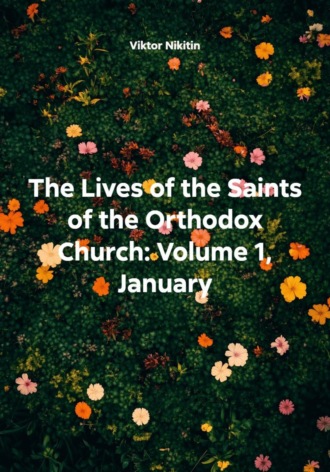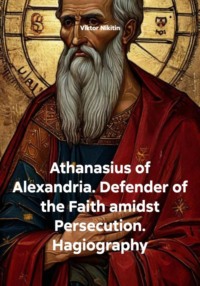
Полная версия
The Lives of the Saints of the Orthodox Church: Volume 1, January

Viktor Nikitin
The Lives of the Saints of the Orthodox Church: Volume 1, January
Lives of the Saints Celebrated on January 1
Martyr Theodotus:
Theodotus was a Christian martyr who suffered by the sword during early persecutions, likely in the 2nd or 3rd century. Known for his fearless confession of faith in the face of Roman authorities, he became an exemplar of steadfastness. His death inspired early Christians to endure suffering with courage, symbolizing the victory of faith over worldly power.
Martyr Basil of Ancyra (362):
Basil was Bishop of Ancyra during the reign of Emperor Julian the Apostate, who attempted to revive paganism and suppress Christianity. Basil boldly confronted the emperor’s attempts to dismantle the Church, refusing to compromise his faith. He endured imprisonment, torture, and ultimately martyrdom by the sword, cementing his legacy as a courageous defender of Orthodoxy during a critical period of apostasy and persecution.
Saint Gregory of Nazianzus the Elder (d. 374):
Gregory the Elder shepherded the Christian community as Bishop of Nazianzus in Cappadocia. Renowned for his humility and pastoral zeal, he raised his family in the Christian faith, most notably his son Gregory the Theologian, who would become one of the Great Cappadocian Fathers and a key figure in the development of Trinitarian theology.
Saint Emilia (d. 375):
Emilia is venerated as the devout mother of several influential saints: Basil the Great, Macrina the Younger, Gregory of Nyssa, Naucratius, Peter of Sebaste, and Theosebia the Deaconess. She nurtured a Christian household renowned for its piety and intellectual depth. Emilia’s role as matriarch was pivotal in the formation of early Christian monasticism and theology.
Saint Basil the Great, Archbishop of Caesarea (379):
One of Christianity’s greatest theologians, Basil was instrumental in shaping the Nicene Creed, defending the doctrine of the Holy Trinity, and combating Arianism. He reformed monastic life with a focus on community living, charity, and liturgical richness, and authored the Divine Liturgy of St. Basil, still used in Orthodox worship today. His social programs set a precedent for Christian philanthropy.
Saint Theodosius of Tryglia:
An abbot known for his ascetic discipline, Theodosius established a monastic community in Tryglia characterized by strict adherence to prayer, fasting, and manual labor. His leadership contributed to the flourishing of monastic spirituality in Byzantine Syria during the 5th century.
Hieromartyr Concordius of Spoleto (ca. 175):
A priest who suffered martyrdom under the Roman persecutions of Marcus Aurelius, Concordius is remembered for his unwavering commitment to Christ. After enduring imprisonment and torture for refusing to sacrifice to the pagan gods, he was executed by the sword, inspiring the early Christian community with his witness.
Thirty Soldier-Martyrs in Rome (ca. 304):
This group of Christian soldiers were executed under Emperor Diocletian’s persecution for refusing to partake in pagan sacrifices. Their martyrdom exemplifies the conflict between military duty and Christian faith, highlighting the challenges faced by early Christians serving in the Roman army.
Martyr Telemachos (Almachius) (404):
Once a soldier himself, Telemachos became a monk and was deeply disturbed by the violence of gladiatorial games. In a bold act of faith, he entered the Roman amphitheater to stop the games, appealing to the spectators’ conscience. Instead, the crowd turned on him and killed him. His martyrdom contributed to the eventual banning of gladiatorial combat.
Saint Basil, Bishop of Aix-en-Provence (ca. 475):
Serving in a period marked by the fall of the Western Roman Empire and the rise of barbarian kingdoms, Basil upheld Christian teaching and pastoral care in southern Gaul. He is remembered for his charity and efforts to maintain ecclesiastical order amid political turmoil.
Saint Eugendus, Abbot of Condat Abbey (510):
The fourth abbot of Condat Abbey in the Jura Mountains, Eugendus is noted for his humility, asceticism, and strict monastic discipline. Under his guidance, the monastery became a beacon of spiritual life and education, influencing monasticism in early medieval Gaul.
Saint Fanchea of Killeany (ca. 520):
Sister to St. Enda of Aran, Fanchea was a monastic founder and ascetic who helped spread Christianity in Ireland. Her commitment to prayer and communal monastic life aided in the Christianization of the Irish people.
Saint Fulgentius of Ruspe (533):
Bishop of Ruspe in North Africa, Fulgentius was a powerful theological voice against Arianism and Donatism. His extensive writings on grace, free will, and original sin influenced both Eastern and Western Christian theology and were cited by later Church Fathers.
Saint Justin of Chieti (ca. 540):
As bishop during the time of the Ostrogothic rule in Italy, Justin preserved orthodox Christian teaching and strengthened the local Church. His episcopacy was marked by efforts to maintain ecclesiastical discipline and pastoral care during a volatile period.
Saint Felix of Bourges (ca. 580):
Felix was a bishop noted for his holiness and pastoral dedication in Bourges, France. He worked to maintain Christian orthodoxy and care for the poor during the transitional period from Roman to Frankish rule.
Saint Connat (Comnatan), Abbess of Kildare Abbey (ca. 590):
Abbess Connat led the important monastery of Kildare in Ireland, a major center of Irish Christianity founded by St. Brigid. Under her leadership, the abbey flourished as a spiritual, educational, and cultural hub.
Saint Maelrhys (6th century):
A local saint of Bardsey Island, Wales, Maelrhys was a recluse known for his ascetic life and spiritual intercession, contributing to the island’s reputation as a sacred pilgrimage site.
Saint Clarus, Abbot of St. Marcellus Monastery (ca. 660):
Abbot Clarus was known for his austere monastic rule and holiness in the monastery of Vienne, Gaul. He was influential in strengthening monastic discipline and spiritual fervor in his community.
Saint Cúan (Mochua, Moncan) (752):
An Irish abbot and missionary, Cúan founded numerous churches and monasteries throughout Ireland, helping to consolidate the Christian faith in his homeland during the early medieval period.
Saint Peter of Atroa (Peter the Standard-Bearer) (837):
Abbot Peter was a zealous opponent of Byzantine iconoclasm, defending the veneration of icons at great personal risk. His leadership helped preserve Orthodox tradition during a time of imperial suppression (see also January 3 Eastern calendar).
Saint William of Dijon (William of Volpiano) (1031):
A monk, architect, and reformer, William revitalized Benedictine monasticism across Europe. His architectural works helped define Romanesque style, and his reforms influenced religious life, emphasizing strict observance and education.
Saint Peter Mogila (1646):
Metropolitan of Kyiv and Halych, Peter Mogila was a renowned theologian and church reformer who strengthened Orthodox doctrine and education during a period of Latin Catholic and Protestant challenges. His catechism remains a foundational text in Orthodox theology.
New Martyr Peter of Tripolis (1776):
Martyred under Ottoman rule for refusing to renounce Christianity, Peter’s steadfast faith inspired the Orthodox faithful living under Muslim domination, embodying the endurance of Christian witness.
Saint Athanasius (Volkhovsky) (1801):
Bishop of Mohyliv, known for his wonderworking and miracles in Poltava, Russia. Athanasius was deeply respected for his pastoral care and spiritual guidance during a period marked by social change.
New Hieromartyr Jeremiah (1918):
A priest martyred in the early years of Soviet persecution against the Church. Jeremiah remained faithful despite imprisonment and execution, symbolizing the suffering of clergy under communist oppression.
New Hieromartyrs Platon (Kulbush), Bishop of Tallinn, Estonia, and Protopresbyters Michael (Blaive) and Nicholas (Bezhanitsky) (1919):
These hierarchs were victims of the Red Terror, executed for their refusal to abandon the Orthodox faith during the Bolshevik rise to power. They are remembered for their pastoral dedication and martyrdom in Estonia.
New Hieromartyrs Alexander (Trapitsyn), Archbishop of Samara, and Priests John (Smirnov), Alexander (Ivanov), Alexander (Organov), John (Suldin), Trophimus (Miachin), Viacheslav, Basil, and James (1938):
Executed during the Stalinist purges, these hierarchs and priests bore witness to the faith under extreme persecution. Their martyrdom highlights the tragic suffering of the Russian Orthodox Church in the 20th century and their enduring spiritual legacy.
* * *
Lives of the Saints Celebrated on January 2
Saint Theodota:
Saint Theodota lived in the 3rd century and is honored as the mother of the Holy Unmercenary Physicians, Saints Cosmas and Damian. She was a devout Christian who raised her sons in the faith, nurturing their love for Christ and the sick. Cosmas and Damian became known for healing people without accepting payment, giving all glory to God. Theodota’s own faith and example were crucial in shaping their spiritual path. She is remembered for her piety, her role as a mother, and her support of her sons’ holy mission.
Martyr Sergius:
Sergius was a Christian martyr who lived in the early 4th century. During the persecution of Christians under Emperor Diocletian, Sergius was arrested at Caesarea in Cappadocia for openly confessing Christ. He endured harsh torture and ultimately was executed by the sword in 301. His martyrdom is a testament to his unwavering faith, courage, and dedication to Christ even unto death.
Martyr Theopistus (Theopistos):
Theopistus was a devout Christian who suffered martyrdom by stoning for refusing to renounce his faith. Though specific details about his life are limited, his martyrdom reflects the steadfast faith and patience of many early Christians who faced brutal persecutions without wavering.
Hieromartyr Theogenes:
Theogenes was the Bishop of Parium, a city on the Hellespont, in the early 4th century. He shepherded his flock during a time when Christianity was still dangerous and persecuted in many parts of the Roman Empire. For his faith and leadership, he was arrested and martyred, becoming a shining example of episcopal courage and steadfastness.
Saint Sylvester I of Rome:
Saint Sylvester served as Pope of Rome from 314 until his death in 335. He guided the Church during a crucial period when Christianity transitioned from persecution to imperial favor, under Emperor Constantine the Great. Sylvester is celebrated for his participation in the First Council of Nicaea in 325, which firmly established orthodox Christian doctrine, particularly affirming the divinity of Christ against Arianism. He is traditionally credited with founding several churches and fostering the growth of Christianity throughout the empire.
Martyr Basil of Ancyra:
Basil was a Christian in Ancyra who was martyred under Emperor Julian the Apostate around 362. Julian sought to revive paganism and suppress Christianity after Constantine’s era of tolerance. Basil refused to renounce his faith despite imprisonment and torture, embodying the courage of Christians during this difficult era.
Hieromartyr Isidore:
Isidore was Bishop of Syrian Antioch in the 4th century and a defender of the Nicene Creed during the theological controversies surrounding Arianism. Opposed by the Arians for his orthodox beliefs, he was ultimately martyred for his firm defense of the true faith, thus upholding the doctrine of the Holy Trinity.
Venerable Theopemptus (Theopemptos):
Theopemptus was a monk renowned for his asceticism and spiritual insight. He lived a life of prayer, fasting, and humility, inspiring others through his example of monastic devotion. Though few details are known, his life exemplifies the dedication required of early monastic saints.
Righteous Mark the Deaf-Mute:
Mark was born deaf and mute but lived a life of great righteousness and faith. Despite his physical limitations, he demonstrated deep spiritual insight and patience, inspiring those around him. His life is a powerful reminder that holiness transcends physical condition.
Venerable Ammon of Tabennisi:
Ammon was a 5th-century monk in Egypt, disciple of St. Pachomius, the founder of cenobitic monasticism. He lived an austere life of obedience and prayer in the desert, contributing to the development of monastic communities and the spiritual formation of monks.
Martyrs Artaxus, Acutus, Eugenda, Maximianus, Timothy, Tobias, and Vitus:
These martyrs suffered in Syrmium (modern Sremska Mitrovica, Serbia) in the 3rd or 4th centuries, bravely confessing Christ despite persecution. Their deaths exemplify the widespread trials faced by early Christians across the Roman Empire.
Martyrs of Rome:
During the Diocletian persecution around 303, numerous Christians in Rome refused to surrender the Holy Scriptures or renounce their faith. These martyrs endured torture and death, their sacrifice strengthening the Church and serving as a beacon for future believers.
Thousand Martyrs of Lichfield:
Led by Hieromartyr Amphibalos, a thousand martyrs suffered in Lichfield, England, under Diocletian’s rule around 303. The name Lichfield means “field of bodies,” commemorating this vast martyrdom. Their bravery is honored as a testament to faithfulness in hostile lands.
Saint Martinianus of Milan (Maternian):
Martinianus served as Bishop of Milan in the 5th century. He was a participant in the Third Ecumenical Council (Ephesus, 431) which condemned Nestorianism, defending the unity of Christ’s divine and human natures. Martinianus also wrote against heresies and strengthened the orthodox faith in his region.
Saint Aspasius of Auch:
Aspasius was Bishop of Auch in the 6th century, attending several Church councils that addressed discipline and heresy. His leadership helped consolidate the Church in Gaul, and his guidance was important in formative years of the Church in that region.
Saint Schottin (Schotin, Scarthin):
Schottin was a 6th-century Irish hermit from Kilkenny, living a life of prayer, fasting, and solitude. He was known for his holiness and miracles, influencing Irish monasticism. His feast is also observed on January 6.
Venerable Saint Seiriol the Righteous:
Seiriol was the abbot of Penmon Priory in Wales during the 6th century. Renowned for his saintliness, he led his monastery with humility and compassion, inspiring many through his miracles and spiritual guidance.
Saint Munchin the Wise (Mainchín of Limerick):
Munchin was the first bishop of Limerick in the late 6th century. Celebrated for his wisdom and pastoral care, he is venerated as the city’s patron saint, playing a key role in spreading Christianity in Ireland.
Saint Blidulf (Bladulf):
Blidulf was a monk at Bobbio Abbey in Italy in the 7th century. He bravely denounced the Arian heresy of King Ariovald, standing for the true faith despite danger. His martyrdom is remembered as a testimony to courage and orthodoxy.
Saint Vincentian (Viance, Viants):
Vincentian was a disciple of Saint Menelaus and became a hermit near Tulle in Auvergne, France, in the 8th century. He lived a life of prayerful solitude and holiness.
Saint Adalard of Corbie:
Adalard was a Frankish nobleman who became a monk and reformer, dying in 827. Known for his leadership in monastic reform and spiritual teaching, he helped shape the monastic tradition in Western Europe.
Saint Cosmas I of Constantinople the Wonderworker:
Cosmas I served as Patriarch of Constantinople in 1081. Known for miracles and unwavering defense of Orthodoxy, he is revered for his pastoral wisdom and spiritual strength.
Saint Sylvester of the Kiev Caves:
A 12th-century monk of the Kiev Caves Lavra, Sylvester lived a strict ascetic life, dedicating himself to prayer and guidance of others in monasticism. He is remembered for his holiness and devotion.
Righteous Juliana of Lazarevo:
Juliana lived in Russia in the early 17th century and was known for her pious, charitable life. As a noblewoman, she used her position to help the poor and needy, becoming an example of holiness in the secular world.
New Martyr George (Zorzes, Zorsisus) the Georgian:
George was martyred in 1770 at Mytilene for refusing to abandon Christianity under Ottoman persecution. His steadfastness in faith despite torture made him a beloved new martyr.
Venerable Saint Seraphim of Sarov, Wonderworker:
Seraphim (1759–1833) is one of the most beloved Russian saints. He was famous for his deep prayer life, miracles, teachings on acquiring the Holy Spirit, and profound humility. Many miracles and healings are attributed to him.
New Martyr Basil:
Basil was martyred in 1942 during Soviet anti-Christian persecutions. He remained faithful to Christ even under threat of death, inspiring many in the modern era.
New Hieromartyr Dmitri Shpakovsky:
Dmitri was a priest who suffered martyrdom in 1942 under Soviet oppression. He bore witness to Christ with courage, refusing to deny his faith even when faced with torture and death.
Other Commemorations:
Archimandrite Joanniky Golatovsky (1688), noted for his spiritual guidance.
Hieroschemamonk Gabriel of Optina and Whitehoof Convent (1871), revered elder.
Abbess Thaisia of Leushino Monastery (1915), remembered for holiness.
Martyred Elder Ioasaph of St. Tikhon of Kaluga Monastery (1919).
Elder Iakovos of Epirus (1961), known for his spiritual wisdom.
* * *
Lives of the Saints Celebrated on January 3
Holy Prophet Malachi (ca. 400 BC):
Malachi, whose name means "my messenger," is considered the last prophet of the Old Testament. He lived around the 5th century BC after the return of the Jewish people from Babylonian exile. Malachi’s prophetic writings called Israel to repentance and faithfulness, rebuking the priests and people for laxity in worship, injustice, and social sins. He foretold the coming of the "messenger of the covenant," understood in Christianity as John the Baptist and ultimately Jesus Christ. His message bridges the Old and New Testaments, emphasizing God’s justice and mercy.
Martyr Peter, in Avlona of Samaria, Palestine (311):
Peter was an early Christian martyr in Avlona, a city in the region of Samaria in Palestine. During the fierce persecutions under the Roman emperor Maximinus Daia, Peter was arrested for openly professing his Christian faith. Despite brutal torture designed to force him to renounce Christ, Peter remained steadfast and was eventually put to death. His martyrdom stands as a powerful testimony to faithfulness in the face of suffering.
Martyr Gordius, Centurion at Caesarea in Cappadocia (ca. 314):
Gordius was a Roman centurion who came to believe in Christ and openly confessed the Christian faith. His position as a soldier and officer made his conversion especially significant and dangerous. Refusing to recant, Gordius was arrested and sentenced to death by the sword in Caesarea, Cappadocia. His martyrdom around 314 exemplified courage and the transformative power of faith, inspiring many in the early Church.
Venerable Meliton of Beirut (537):
Meliton was a monk and ascetic who lived in Beirut, Lebanon, during the 6th century. Known for his devout prayer life, humility, and miracles, he exemplified the monastic ideals of the time. Meliton’s spiritual wisdom attracted many disciples, and his life was a beacon of holiness in the region. His intercessions are still sought for healing and guidance.
Venerable Peter of Atroa (Peter the Standard-Bearer) (837):
Peter of Atroa was a monastic leader and staunch defender of the veneration of icons during the period of Byzantine iconoclasm. His nickname "the Standard-Bearer" reflects his role as a leading figure resisting imperial decrees against icons. Living a life of prayer, teaching, and courage, Peter became a spiritual pillar for Orthodox Christians during one of the Church’s greatest trials. He is commemorated also on January 1 in the Western tradition.
Venerable Acacius the Wonderworker of Mount Latros (ca. 10th century):
Acacius lived as a monk at the Megisti Lavra of the Theotokos of Myrsinon on Mount Latros, a center of monasticism in Asia Minor. Renowned for his asceticism, humility, and miracles, Acacius’s life inspired many monastics. His wonderworking is attested by numerous healings and spiritual gifts, contributing to his veneration as a holy ascetic.
Righteous Thomais of Lesbos (10th century):
Thomais lived on the Greek island of Lesbos during the 10th century. She was known for her deep piety, charity, and modest life. Her dedication to prayer and care for the poor made her an example of Christian virtue in the Byzantine world.
Hieromartyr Daniel of Padua (168):
Daniel was a deacon assisting St. Prosdocimus, the first Bishop of Padua in northern Italy. In the early years of Christianity, Daniel devoted himself to serving the Church and the poor. He was martyred for his faith during the Roman persecutions, giving his life as a witness to Christ’s love and sacrifice. His legacy is particularly venerated in northern Italy.
Saint Anterus, Pope of Rome (236):
Pope Anterus led the Church of Rome during a challenging period marked by persecution and doctrinal disputes. His papacy lasted only a short time before he was martyred for his faith. He is remembered for his pastoral zeal, safeguarding the faith and strengthening the Church during turbulent times. Anterus’s feast is observed in both Eastern and Western Christian traditions.
Hieromartyr Florentius of Vienne (3rd century):
Florentius was the Bishop of Vienne in France and suffered martyrdom under Roman persecution. Known for his courage in defending the Christian faith, he shepherded his community with wisdom and courage until his death. His martyrdom helped establish the Church in Gaul.
Venerable Genevieve of Paris (502):
Genevieve is celebrated as the patroness of Paris. Born into a humble family, she dedicated her life to asceticism, prayer, and charity. Her most famous act was interceding through prayer to save Paris from the invasion of Attila the Hun. Genevieve’s life is marked by miracles, including healing and prophecy, and she became a symbol of spiritual protection and maternal care for the city.
Saint Blitmund, Monk at Bobbio Abbey (ca. 660):
Blitmund lived at Bobbio Abbey in northern Italy, a center founded by St. Columbanus. He was known for his ascetic life, teaching, and devotion to monastic discipline. His holiness contributed to the spiritual growth of the community and the spread of monastic ideals in the region.
Saint Bertilia of Mareuil, Anchoress (ca. 687):
Bertilia chose a life of solitude as an anchoress, dedicating herself to prayer, fasting, and contemplation. Living near Mareuil, she became known for her holiness and spiritual insight, guiding many through her example and intercessions.
Saint Fintan of Doon (6th century):
Fintan was a disciple of Saint Comgall at Bangor, one of Ireland’s great monastic centers. He later became the patron saint of Doon in County Limerick. Fintan was noted for his asceticism, teaching, and care for the faithful. His life contributed to the flourishing of Irish monasticism and Christian education.
Saint Finlugh of Derry (Finlag) (6th century):
Brother of Saint Fintan, Finlugh became abbot of a monastery in County Londonderry. Like his brother, he was dedicated to prayer, monastic discipline, and pastoral care, influencing many through his leadership.
Saint Findlugan of Islay (7th century):
Findlugan (also known as Finlaggan or Fionn Lugain) was an early Scottish saint who lived a monastic and ascetic life on the island of Islay. He is remembered for his holiness and contribution to early Scottish Christianity.
Saint Wenog:
Wenog was an early saint of Wales, known for his missionary work and holiness. Though details are limited, he is venerated in Welsh tradition for spreading Christianity and living a virtuous life.









